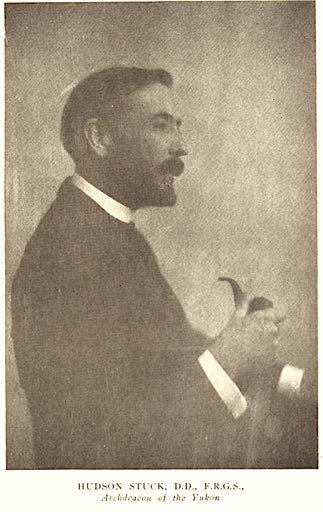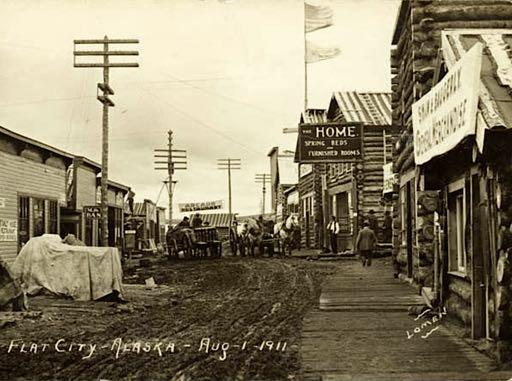
8 minute read
THE EPISCOPAL CHURCH IN IDITAROD & FLAT CITY BY HUDSON STUCK, D.D., F.R.G.S

Author Hudson Stuck, from his book.
The Episcopal Church in Iditarod &Flat City 1909 ~ 1911 ~ Hudson Stuck D.D.F.R.G.S.~
Advertisement
Hudson Stuck, born in England in 1863, came to the United States at the age of 22. In 1889 he began formal theological studies in Texas and was ordained deacon on Aug. 7, 1892, and an Espicopal priest on Nov. 30, 1892. He served the church in Texas until 1904, when he moved to Alaska to become Archdeacon of the Yukon in the Missionary District of Alaska. He explored the territory extensively and published many articles and several books describing his journeys, including The Alaskan Missions of the Episcopal Church in 1920. This article is an excerpt from Chapter IV: By Dog Sled or Launch.
The Iditarod was the last major gold rush in Alaska, covering a vast area spreading from Ruby on the Yukon River, south along the Kuskokwim Mountain into the drainages of the Innoko and Upper Kuskokwim Rivers, centering in the towns of Flat and Iditarod. Prospectors had visited the area since the 1880’s, and minor stampedes had kept interest in the area alive. And then on Christmas Day, 1908, three miners found what they’d been searching for on a tributary of the Innoko River and over the next decade $30 million worth of gold was dug from the ground.
From The Alaskan Missions of the Episcopal Church (1920), by Hudson Stuck:
In the roughly chronological order which has been observed in this narrative, this is the place to speak of the Iditarod, and since the history of the Church in that camp is in all probability a closed chapter, the complete incident may illustrate the difficulties in the way of undertaking religious work in a placer mining camp.

First Avenue in Iditarod, circa 1911.
It is true of every such camp that, besides yielding up its own gold, it acts as a base of supplies for prospecting further afield; since the limit of the prospector’s wanderings is the distance to which he can transport supplies by his dogteam. The region between the Yukon and the Kuskokwim rivers was late in being examined for minerals because there was no base of supplies—save on the Yukon itself, too far away to be practicable. It was the discovery of gold on the Innoko, one of the southern tributaries of the Yukon, the establishment of the small town of Ophir near its headwaters, and the navigation of that river by steamboats, that led to the gold discovery on the Iditarod River, one of the tributaries of the Innoko, and the great stampede that took place in the summer of 1910.
It was the last of the great stampedes. Word had been coming out all the winter of the richness of Flat Creek. Before the Yukon was open to through traffic from the United States, there was a constant stream of voyagers from all the upper river camps, and so soon as the through steamboats ran, the gold seekers from the outside crowded them from stem to stern.
We took the Pelican up to Iditarod City in August with the Bishop aboard, and at that time I suppose Iditarod City had more population than any other town in Alaska. Great drafts had been made on all the towns of the interior. Many of the tradesmen of Dawson and Fairbanks had removed bodily with all their stocks of merchandise; some of the lesser camps had been quite depopulated; several thousands of people had come from the coast towns and from the States. Tents were already largely replaced by frame structures which rose from the glacial muck upon which the town was built with magical rapidity. A tramway was already constructing from Iditarod City to the creek ten miles away where the gold had been found.
The writer visited the place again in the winter, going in by the Kuskokwim, and spent a week there, and left, having doubts about the wisdom of undertaking any building. But that winter a consignment of gold was sent overland by dogteam to Seward on the coast, in rather a spectacular way, and was shipped to Seattle with much trumpeting by the newspapers. One always suspects the transportation companies of doing all they can to increase any excitement that promises to be profitable to them. The sensational New York magazines were printing articles about "The Incalculable Riches of Alaska" all that winter, and much adventurous cupidity was stirred up.
At the opening of navigation in 1911 the archdeacon received a telegram from the Bishop, directing him to go into the Iditarod immediately, raise the necessary funds and build a hospital—nurses and equipment for which would come in on the first boat—which task was forthwith undertaken and that summer executed. The need of an hospital was certainly great, as is always the case in such large gatherings of men, but the task of securing the $3,000 that was raised locally was no small one. However, the money was obtained, a building that had been erected for an hotel was purchased and partly paid for, the nurses and equipment arrived and the hospital was opened.
Flat Creek was not only rich, it was shallow; and that is unfavourable nowadays to the fortune of a placer mining camp, because it is such deposits that are most suitable for dredging. The Guggenheims sent an agent that summer who bought "options" on all the claims on Flat Creek and spent considerable sums in prospecting them with drills and pretty accurately estimating their value. At the conclusion of his operations all the options were thrown up, as being held at prices which their gold-content did not justify. But early in the next season the owners proved willing to sell at what the Guggenheims considered a fair valuation—and the whole of Flat Creek passed into their hands.
Now it may seem at first sight that it does not matter by what means the gold is extracted from the ground, so that it is extracted in sufficient quantity, but it makes a great deal of difference to the community. If fifty separate claims are working, each with a crew of men, there is much employment and much business catering to the miners. But two or three dredges will do the work that kept that whole population busy and dredges do not eat, or wear clothes, or drink whiskey or get sick and go to the hospital. Very little gold had been discovered save on Flat Creek itself; prospecting of the numerous neighbouring creeks had been unsuccessful. The dreams of a wide auriferous region, of which Flat Creek was only a beginning, proved a delusion.
The dredges killed Iditarod City. Presently there was almost as great an exodus of people as there had been influx. The little town on Flat Creek itself was town enough for the reduced population; one by one the large buildings of Iditarod City were vacated, and the place began to assume the familiar melancholy aspect of so many decayed settlements in the interior.
The hospital at Iditarod City had to be closed. For awhile one nurse and part of the equipment were moved over to Flat City and sufficed for the reduced needs of the camp. Then some largely fictitious claim for services was made by an attendant, suit was brought in the local court, and before it was possible to enter plea in answer, judgment was given and the equipment was sold at auction. There was legal redress had it been worthwhile resorting to it, but the people were gone and with them the need for the hospital, while to have removed the equipment at the freight rates prevailing in the Iditarod would have cost more than it was worth.

Iditarod
So Iditarod City stands, with our empty hospital, an empty Roman Catholic Church, an empty Presbyterian reading and club room; one more example (though perhaps the most striking, since Iditarod City lasted such a short while) of the unsubstantial and precarious nature of a placer gold mining town. At Fairbanks Bishop Rowe took the chance—and it proved abundantly worth while. And it must be remembered that hundreds of others— merchants and tradesmen of every kind—long used to the country, also thought the Iditarod chance worth taking.
It was, I think, the upshot of the Iditarod venture that decided the Bishop not to embark the Church’s money on any more hospitals in placer mining camps. For the medical needs of the natives had been pressing a long time upon the hearts of those concerned with the Yukon country. White men, where they congregate in sufficient numbers to require hospital service, are commonly able to pay for it, and, therefore, able to procure it. It is true that it is often the last thing thought of. It is true that the intense and universal preoccupation with getting, the feverish excitement of the early days of a new gold camp, leave no leisure for the contemplation of inevitable sickness and injury and the proper provision therefor ; that what is everyone’s business in general is likely to be no one’s business in particular, and that the Church has served community after community in this matter very valuably and beneficially because she was the only present agency sufficiently detached and disinterested to foresee the need and take the necessary steps to meet it. I do not feel any need to defend or excuse the undertakings of this kind to which we have set our hands from time to time in Alaska.
But our white population is an exceedingly fluid quantity, as those who have read these pages will understand. A new "strike" anywhere draws the men away from all the older camps. The white men come and go ; they rush in to new diggings, overwhelming the town, stripping its stores of everything, and then subsisting on half rations eked out with rabbits and ptarmigan until the reopening of navigation allows supply to catch up once more with demand. Sooner or later they depart, not usually with the rush that depopulated the Iditarod in 1912-13, but in driblets, until the population will no longer support the stores and the institutions and they close their doors and cease; while another town grows up, perhaps a thousand miles away, with the same pressing immediate needs and temporary prospects. ~•~







